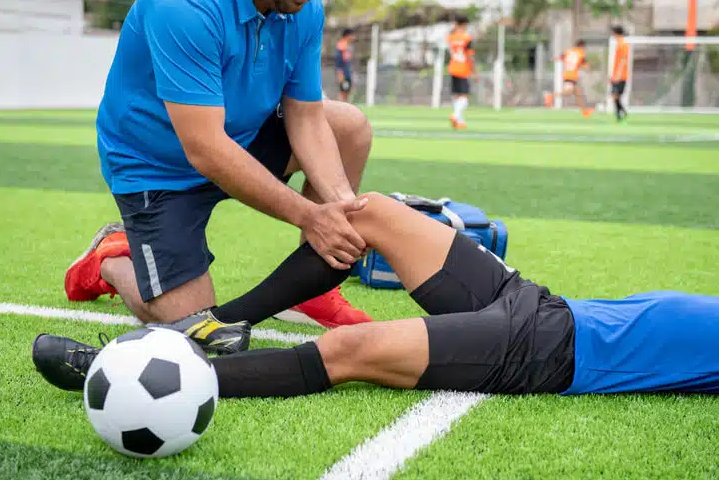How to Prevent Injuries in Sports with AI Tools?

Sports injuries are among the constant nightmares for athletes and teams worldwide, given that they don’t just stop performance but also potentially lead to serious long-term health consequences. However, the advent of AI has transformed the field of sports medicine and offers innovative ways to prevent injuries in sports. This article considers how AI-powered tools can keep athletes safe and training smart to avoid setbacks.
What Are the Most Common Sports Injuries?
Before discussing the ways of preventing injuries in sports, it is necessary to understand the nature of the injuries. The common sports injuries include the following:
- Knee injuries including tears to the ACL and menisci.
- Sprains and strains mainly to the ankle and hamstring.
- Shoulder injuries including tears to the rotator cuff and dislocations. Stress fractures common among runners and basketball players.
- Concussions especially among those into contact sports like football and hockey.
These injuries can be due to overuse, poor biomechanics, or sudden trauma. Consequently, the prevention of injury in sport has to be developed from an understanding of the exact sport and the risks of the athlete.
How Can AI Be Used to Analyze Athlete Movement Patterns and Identify Potential Injury Risks?
AI can process high volumes of video data and sensor readings to find the pattern and analyze how an athlete moves. Correspondingly, machine learning algorithms identify the biomechanical anomalies-i.e., the wrong angles in joints and poor distribution of body weight that could trigger an injury.
In this light, the following may become possible from an AI-based system to prevent injuries in sports:
- Gait analysis of a particular athlete: Identifying possible asymmetries, which put one at increased risk of a stress fracture.
- Studying jump and landing techniques and making predictions on knee injury prevention for sports-related, such as an ACL tear.
- Allow identification of subtle changes in performance that would indicate fatigue as one of the major risk factors for injury.
Equipped with AI real-time feedback, immediately athletes and coaches can make an adjustment to keep the chances low.
What Specific AI Technologies Are Being Used in Sports Medicine Today?
Various innovative AI technologies that help to prevent injuries in sports include:
- Computer Vision: It assesses movements from video footage and detects techniques that may be harmful.
- Machine Learning: Predicts injury risks by using historical and real-time data.
- AI-Powered Wearables: Devices equipped with sensors that monitor biomechanics and workload.
- Natural Language Processing: Interprets medical records and athlete feedback for patterns in injury history.
These technologies are being applied more and more to training, putting teams one step ahead in injury prevention.
How Can AI-Powered Wearable Devices and Sensors Monitor Athlete Biomechanics?
Wearables and sensors powered by AI are the game-changers in injury prevention. These devices track real-time data from metrics including joint angles, muscle activity, and ground reaction forces.
- Example 1: Smart insoles measure foot pressure distribution to identify gait abnormalities.
- Example 2: Compression garments with integrated sensors will monitor muscle fatigue throughout one’s exercises.
The AI then analyzes this data to form actional insights, such as recommending rest periods or corrective exercises. This kind of real-time monitoring helps athletes prevent injuries by fixing problems before they escalate.
How Can AI Be Used to Personalize Training Programs?
Generalized training programs cannot account for individual differences, which can put certain athletes in greater danger of sustaining an injury. AI bridges this gap by tailoring each training regimen to the biomechanics, fitness level, and injury history unique to each individual athlete.
- Personalized workloads: AI scales the intensity of training to avoid overuse injuries.
- Personalized exercises: based on data from biomechanical investigations, the AI could recommend the exercise to be performed in view of stabilizing muscles that hold the knee from traumatizing due to injury.
- Progress tracking: AI tracks improvements made by an athlete over time and keeps training challenging yet safe.
This personalized approach will help athletes perform at their best while helping prevent injuries in sports.
What Role Can AI Play in Predicting and Preventing Catastrophic Injuries?
Injuries such as torn ligaments or serious concussions can bench athletes for months or even end careers. Predictive capabilities with AI give some hope in those scenarios.
- Early Warning Systems: AI finds warning signs, such as increased strain on ligaments, to alert athletes and coaches in advance of serious injury.
- Impact Analysis: AI will analyze data from collisions in contact sports to predict and potentially prevent concussions or other types of spinal trauma.
AI minimizes the risk of life-changing injuries by acting like a virtual safety net.
What Are the Ethical Considerations and Potential Biases Associated with the Use of AI in Sports Medicine?
While AI has huge promise, several key issues regarding its application in sports medicine should be considered:
- Privacy: Wearables and sensors collect sensitive data. Ensuring this data is securely stored and ethically used is paramount.
- Biases in Algorithms: If the AI model is tuned on a restricted dataset, it may fail to give good results across different body types, genders, or ethnic backgrounds.
- Overdependence on Technology: AI is a powerful tool, but it should support, not replace, human judgment in injury prevention strategies.
Addressing these challenges is crucial to building trust and ensuring fair, unbiased outcomes in sports medicine.
What Is the Future of AI in Sports Injury Prevention?
The future is bright for AI in sports injury prevention, with several promising developments on the horizon:
- Wearables: These will be more sophisticated and can provide even more detailed feedback related to biomechanics and fatigue.
- Integrating with Virtual Reality: AI-powered VR environments can simulate game scenarios in which athletes train in safety and identify risky behaviors.
- Team Analytics: AI lets teams keep track of players’ health and performance to enhance their training schedule and reduce injury rates among its members.
As AI continues to evolve, so does its potential to transform sports medicine and prevent injuries in sports.
Conclusions
Unfortunately, sports injuries are inevitable, but AI mitigates the risks and protects athletes through novel ways. From movement pattern analysis to personalized training programs, AI tools are changing the way we think about injury prevention.
These technologies can enable teams and athletes to train smarter, stay healthier, and perform better. AI is not just shaping the future of sports; it’s making them safer for all.




